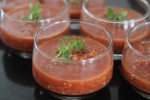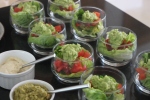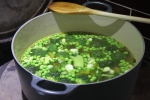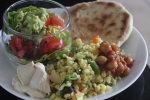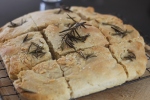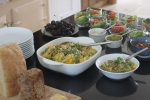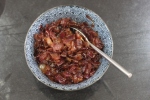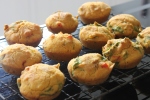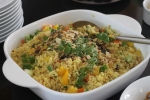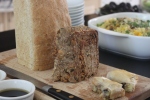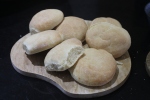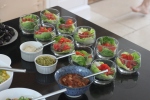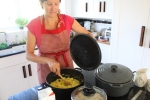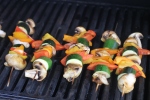Last weekend saw the very first All Roots Mini Yoga Festival take place near Three Cliffs Bay, on Gower in South West Wales. A collection of yoga teachers from several different disciplines joined together with therapists and yoga practitioners, for three days of inspiring yoga classes, sunshine, good company and great food.
As well as teaching the Sunday morning yoga class, it was great that my good friend Jane Easton (Viva!) and I were able to step in at the last moment and cook dinner for everyone on the Saturday evening. During my time at Viva! Jane and I worked together on dozens of events, cooking vegan in bulk for crowds of people at festivals and roadshows – so it was a great reunion for us to cook together once again.
Using lots of key ingredients from Suma, including Chickpeas, Quinoa, Brown Rice and Gluten-free Flour, we used bulk recipes adapted from Viva!’s Vegan Recipe Club to cook up our Moroccan Chickpea Stew, Quinoa Pilaf and Rice, Mixed Salad, Carrot Salad and three varieties of vegan cake; Coffee and Walnut, Carrot and Gluten-free Lemon Cake.
Ingredient lists for most dishes can be multiplied for bulk cooking, but it is always worth bearing the following points in mind when cooking for lots of people;
- Cook the dish first to familiarise yourself with its taste and how the ingredients work together
- Working out the quantities of main ingredients such as vegetables or pulses normally works fine by simple multiplication based on how many people you are feeding
- Seasoning isn’t so simple. You need to season gradually as you go along, tasting to see how spices and salt are behaving in larger quantities. Some won’t go as far and you may need to add more or less
- Some dishes improve with time, like stews or curry, so cook these first, while leaving accompaniments like rice or other grains to nearer serving time
- Don’t be tempted to try to cook everything in one or two large pans. It’s easier to stir and cook large quantities of food spread across several medium-sized pans, especially to be able to stir food with ease
- When cooking in bulk for a specific event, it can save lots of time preparing and chopping vegetables in advance and taking them with you in covered containers
- Weighing out herbs and spices in advance also saves time
- Making use of appliances such as small chopping blenders or food processors can also make bulk cooking quicker (as does having several pairs of hands to help!)
- If you do have a team of helpers, nominate someone to be in charge of chopping, someone overseeing cooking tasks and one or two people keeping on top of the washing and clearing up
- Be mindful of good food hygiene practises. Get people to wash their hands and keep hair tied up
- Discuss how you are going to serve the food before hand and who is responsible for what
- Don’t underestimate the time required afterwards for clearing plates, washing up and leaving the kitchen clean and tidy
- Save money by ordering bulk wholefood items from a specialist supplier such as Suma Wholefoods
Moroccan Chickpea Stew (Bulk)
Preparation/cooking time 60 mins
Serves 35-40 people
180ml extra-virgin olive oil, plus more for garnish
6 large onions, medium diced
3 large bulbs garlic, peeled and blended
45g/3 tbsp ground cinnamon
45g/3 tbsp ground cumin
12.5g/2½ tsp cayenne pepper
75g/12 heaping tsp (sweet) paprika
6 x 400g tins OR 2.4L can of chopped tomatoes
15 x 400g tins Suma chickpeas drained OR 3.6K cooked chickpeas, drained and rinsed well
2.85L/ 6 pints vegetable stock
45g/3 tbsp brown sugar
Salt to taste (adjust if stock is salty)
Freshly ground black pepper
1K pre-washed spinach, chopped OR the equivalent frozen spinach. If using frozen, reduce stock a little
500g/2 jars sun-dried tomatoes, chopped in blender (if in oil, you can use this to replace some of the olive oil)
Optional
Olives – black, green or mixed – chopped
1. Heat olive oil/sun-dried tomato oil in a large pot over medium-high heat. Add the onion and sauté until they begin to turn translucent. Add the garlic to the onions and cook in, lowering the heat if browning starts to occur.
2. Add the cinnamon, cumin, cayenne and paprika and sauté a minute or so. Add tomatoes, chickpeas, stock and sugar. Season with salt and plenty of black pepper.
3. Stir well. The chickpeas should be slightly covered with liquid. If the level is too low, add some water to bring it just above the chickpeas. Bring the mixture to a simmer, and then lower the heat to low and gently simmer for 45 minutes.
4. Remove the soup from heat. Use a potato masher to mash-up some of the chickpeas right in the pot. Stir in the spinach and let it heat through until wilted, just a few minutes. Season again, to taste, with salt and pepper. Serve the soup, and sprinkle the sun-dried tomato pieces on the top with a drizzle of their oil if desired.
We served this with Quinoa Pilaf, organic Quinoa supplied by Suma.
Click on an image to open the gallery.
-

-
Peppers and Tomatoes
-

-
Vegan Cakes
-

-
Coffee and Walnut Cake
-

-
Enjoying dinner
-

-
Ellie’s Yoga Class
-

-
How many people can you fit in a yoga class?
-

-
Ronny icing the GF Lemon Cake
-

-
Moroccan Chickpea Stew
-

-
Bulk Moroccan Chickpea Stew
-

-
Salad
-

-
Cakes and salad
-

-
Jane and Sarah serving
-

-
My Sunday yoga class
-


